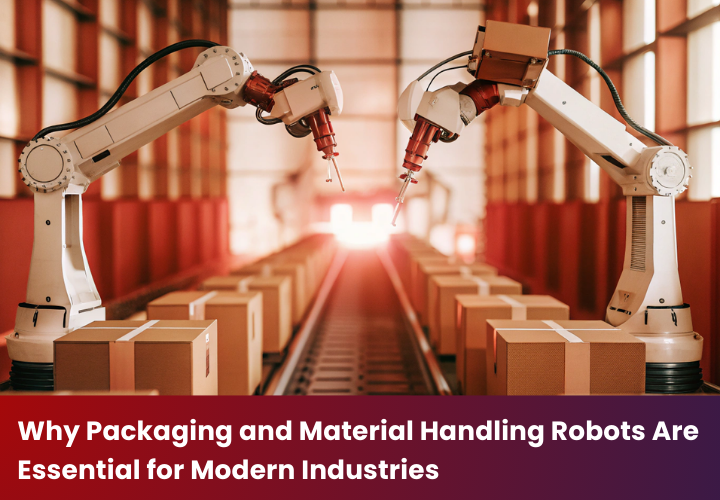
Did you know the global industrial robotics market is projected to exceed $90 billion by 2026? A major driver of this surge is the growing adoption of material handling robots in packaging, logistics, and manufacturing industries. From accelerating packaging lines to ensuring precise movement of goods, these robots are reshaping how modern industries operate—faster, safer, and more efficiently.
But how exactly do they work, and why are they essential in today’s factories and warehouses? Let’s explore.
What Are Material Handling Robots?
Material handling robots are automated systems designed to transport, move, and organize goods within industrial environments. Whether transferring products from one assembly line to another, stacking pallets, or optimizing warehouse logistics, these robots eliminate repetitive manual work and reduce errors.
They are widely used across industries such as e-commerce, automotive, pharmaceuticals, and food & beverages, making them one of the most versatile robotics applications in modern manufacturing.
What Are Packaging Robots?
Closely related to material handling, packaging robots automate product packaging processes like boxing, sealing, wrapping, and labeling. Their precision ensures faster production lines, improved quality, and consistent results.
Packaging robots are often integrated with material handling robots to create seamless end-to-end automation in production facilities.
Types of Packaging Robots
-
Cartoning Robots – Fold, load, and seal cartons.
-
Palletizing Robots – Stack products onto pallets for secure transport.
-
Wrapping Robots – Wrap pallets or products with stretch film for protection.
-
Labeling Robots – Apply labels quickly and consistently across large batches.
Types of Material Handling Robots
Material handling robots come in different forms, each designed for specific applications:
-
Automated Guided Vehicles (AGVs): Transport goods along predefined paths.
-
Robotic Arms: Handle assembly, loading, unloading, and repetitive tasks.
-
Pick and Place Robots: Rapidly move items between points with precision.
-
Conveyor Robots: Automate continuous product flow in manufacturing and storage.
Benefits of Using Material Handling Robots
Adopting material handling robots brings powerful advantages:
-
Speed & Efficiency: Operate faster than humans and run continuously without breaks.
-
Consistency & Accuracy: Reduce errors and maintain quality control in packaging and handling.
-
Cost-Effectiveness: High initial investment but long-term savings in labor and productivity.
-
Improved Safety: Reduce workplace injuries caused by lifting, repetitive motion, or hazardous environments.
-
Scalability: Easily adapt operations to meet fluctuating demand.
Key Industries Benefiting from Material Handling Robots
-
E-commerce & Retail: Streamline inventory management and order fulfillment.
-
Automotive: Safely transport heavy parts and enable precise assembly.
-
Pharmaceuticals: Handle sensitive materials in sterile, hygienic conditions.
-
Food & Beverages: Speed up packaging while maintaining hygiene standards.
Challenges in Adopting Material Handling Robots
While adoption is rising, some challenges persist:
-
High Initial Investment: Difficult for smaller businesses to adopt immediately.
-
Skilled Workforce Requirements: Technicians need training for robot programming and maintenance.
-
Integration Complexities: Retrofitting automation into existing workflows requires planning.
-
Cybersecurity Concerns: Connected robots need strong digital protection against cyber threats.
Future of Material Handling Robots
The future is promising. With the integration of AI, IoT, and machine learning, material handling robots are becoming smarter and more collaborative.
Upcoming trends include:
-
Predictive Maintenance: Robots will self-monitor and alert for service needs.
-
Enhanced Vision Systems: Improved object recognition for handling irregular shapes.
-
Human-Robot Collaboration (Cobots): Safer designs that work directly alongside human workers.
-
Smarter Supply Chains: Adaptive robots that respond dynamically to demand fluctuations.
Best Practices for Implementing Material Handling Robots
To maximize ROI, industries should:
-
Assess Operational Needs – Identify repetitive or hazardous tasks for automation.
-
Start Small, Scale Fast – Begin with simple pick and place robots, then expand.
-
Train Your Workforce – Skilled operators ensure smoother integration.
-
Partner with Experts – Choose experienced robotics solution providers for deployment.
Conclusion
In an era where speed, accuracy, and safety are crucial, material handling robots stand out as game-changers. They not only improve productivity and reduce labor costs but also future-proof industries against rising global demands.
From packaging lines to warehouse logistics, these robots are becoming the backbone of modern manufacturing. Companies that invest early in this technology will secure a lasting competitive edge in the rapidly evolving industrial landscape.
